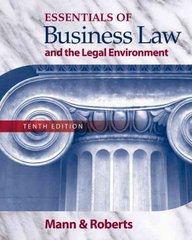Question
Oligopoly Theory Cournot Assume two firms 1 and 2. The inverse market demand function is given by: P=30-(q 1 +q 2 ) Each firm produces
Oligopoly Theory
Cournot
Assume two firms 1 and 2. The inverse market demand function is given by:
P=30-(q1+q2)
Each firm produces with marginal costs of
MC = 6
Fixed costs are zero.
The next questions refer to the Cournot duopoly.
Question 1(1 point)
Saved
What is Firm 1's total revenue function?
Question 1 options:
TR1=30q1-q1-q22
TR1=30-2q1-q2
TR1=30q1-q12-q2
None of the above.
Question 2(1 point)
Saved
What is Firm 1's marginal revenue function?
Question 2 options:
MR1=30-2q1-q2
MR1=30-q1-2q2
MR1=30-2q1-2q2
None of the above.
Question 3(1 point)
Saved
What is Firm 1's response function?
Question 3 options:
q1=12-0.5q2
q1=12-q2
q1=12-2q2
None of the above
Question 4(1 point)
If Firm 1 thinks that Firm 2 chooses to supply q2=10, then Firm 1's profit maximizing quantity would be q1*=
Question 4 options:
6
7
8
10
Question 5(1 point)
If Firm 2 thinks that Firm 1 chooses to supply q1=7, then Firm 1's profit maximizing quantity would be q1*=
Question 5 options:
6.5
7.5
8.5
9.5
Question 6(1 point)
In equilibrium, each firm will supply qi=
Question 6 options:
5
6
7
8
Question 7(1 point)
The market price in equilibrium will be P*(q1+q2)=
Question 7 options:
14
16
18
20
Question 8(1 point)
In equilibrium, each firm's total revenue is equal to TRi=
Question 8 options:
106
108
110
112
Question 9(1 point)
In equilibrium, each firm's total variable cost is TVCi=
Question 9 options:
8
16
32
48
Question 10(1 point)
In equilibrium, each firm's total profit isi=
Question 10 options:
32
40
48
64
Question 11(1 point)
In equilibrium, total consumer surplus is CS=
Question 11 options:
128
169
196
225
Question 12(1 point)
In equilibrium, total welfare is W=
Question 12 options:
225
256
281
312
Stackelberg
The next questions refer to the Stackelberg Leader Follower model. Assume Firm 1 is the leader.
Question 13(1 point)
What is the leader's total revenue function?
Question 13 options:
TR1=42q1-1.5q12
TR1=30q1-1.0q12
TR1=18q1-0.5q12
TR1=6q1-0.25q12
Question 14(1 point)
What is the leader's marginal revenue function?
Question 14 options:
MR1=6-0.5q1
MR1=18-1q1
MR1=30-2q1
MR1=42-3q1
Question 15(1 point)
What is the leader's chosen optimum quantity q1*=
Question 15 options:
6
9
12
15
Question 16(1 point)
What is the follower's s optimum quantity q2*=
Question 16 options:
6
9
12
15
Question 17(1 point)
The market price in equilibrium will be P*(q1+q2)=
Question 17 options:
12
14
16
18
Question 18(1 point)
In equilibrium, the leader's profit isq1=
Question 18 options:
36
72
108
144
Question 19(1 point)
In equilibrium, the follower's profit isq22=
Question 19 options:
36
72
108
144
Question 20(1 point)
In equilibrium, consumer surplus is CS=
Question 20 options:
132
142
152
162
Question 21(1 point)
In equilibrium, total welfare is W=
Question 21 options:
270
280
290
300
Cartel
For the next questions assume that Firm 1 and Firm 2 form a cartel (thus acting together like a monopolist).
Question 22(1 point)
What will be the cartel's marginal revenue function? (where Q=q1+q2)
Question 22 options:
MRC=30-Q
MRC=30-2Q
MRC=30-3Q
MRC=30-4Q
Question 23(1 point)
The cartel's profit maximizing price is PC*=
Question 23 options:
6
12
14
18
Question 24
The cartel's profit maximizing quantity is Q*=
Question 24 options:
12
14
18
20
Question 25(1 point)
Consumer surplus under the cartel solution is CS =
Question 25 options:
50
72
98
128
Question 26(1 point)
Total producer surplus (cartel rent) under the cartel solution is equal to PS =
Question 26 options:
100
144
196
256
Question 27(1 point)
Total welfare under the cartel solution is equal to W=
Question 27 options:
150
216
294
384
Bertrand
The next questions refer to Bertrand competition.
Question 28(1 point)
Betrand criticized the Cournot model. Bertrand's point of criticism was that firms cannot be assumed to compete through
Question 28 options:
quantities supplied
qualities produced
prices set
product differentiation
Question 29(1 point)
In equilibrium, Bertrand competition is equivalent to the model of
Question 29 options:
Monopolistic competition
Perfect competition
Unfair competition
Ruinous competition
Question 30(1 point)
Which statement is true? In equilibrium,
Question 30 options:
The cartel equilibrium price is highest
The Stackelberg leader-follower equilibrium price is higher than the Cournot duopoly equilibrium price
Both a. and b. are correct.
None of the above is correct.
Step by Step Solution
There are 3 Steps involved in it
Step: 1

Get Instant Access to Expert-Tailored Solutions
See step-by-step solutions with expert insights and AI powered tools for academic success
Step: 2

Step: 3

Ace Your Homework with AI
Get the answers you need in no time with our AI-driven, step-by-step assistance
Get Started


